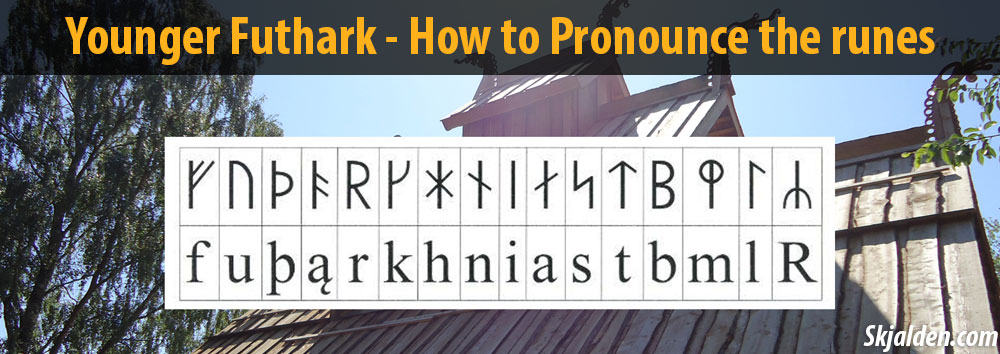The Helm of Awe or The Helm of Terror (Old Norse: Ægishjálmr) is probably one of the most recognized Icelandic symbols, and according to Norse lore, anyone who wears this symbol in battle will be protected from harm.
In this article, we will explore the origin of the Helm of Awe, I will dig into mythological and academic sources. I will show you my approach to find its origin and I hope that you will leave this page more enlightened.
The Helm of Awe can be found in grimoires also called books of spells or books of magic. In contrast to how the Vikings have been portrayed in popular literature, the use of magic was actually a big part of the Nordic religion.

It was the women who according to our current understanding were the religious leaders, and, therefore, magic was mostly practiced by women. But there are also plenty of examples of how men used magic in the Norse sagas.
The Helm of Awe is a stave, a rune spell, and they were carved or painted onto objects for them to take effect. These objects could be pillars, pieces of bark, bones, dirt, or even parts of the body.
It is doubtful that these rune spells were written down in books during the Viking Age, if they were written down, it would most likely have been on animal hide or bark which would decay. Books did not begin to appear before paper became more accessible, and many of these magic books were probably turned into ash in the flames of fear during the dark ages.

The oldest attestation of the symbol that we know of is in the poem Fáfnismál from the Poetic Edda.
In Fáfnismál, stanza 16, it is written: I carried a helmet of the frightener, Ægishjálmr, among men while I laid upon the treasures. I thought myself stronger than all, I did not meet many men. – Translation by Dr. Jackson Crawford.
This stanza tells us that there was something called the Helm of Awe, that not only boosted the confidence of the wearer but also made them feel incredibly strong “I thought myself stronger than all”. It should be said while the name Ægishjálmr is mentioned, there is no depiction of the symbol in this or any of the Norse sagas.
The Helm of Awe could have been an actual helm, because Sigurd, the one who defeated Fafnir and took the treasure, did also take the helm as part of the hoard.
I would also like to point out that Dr. Jackson Crawford has said and I quote, “it seems to be some kind of actual physical helmet, and yet today what is famous under the name Ægishjálmr is not some kind of physical helmet that you put on your head but a symbol that comes from a much later manuscript.”

This manuscript is called Lbs 143 8vo, and it was compiled in the mid-1600s. The symbol Ægishjálmr is depicted on page 11r, where it is described as.
“Ægishjálmr, it must be made in lead and printed on one’s forehead when a man has an expectation that he might meet his enemy and you will overcome him.” – Translation by Dr. Jackson Crawford.
There are also other manuscripts, for instance, the manuscript called AM 434 a, or the Icelandic dark magic book from the 1500s that has both a description and an image of the symbol. I won’t go into detail on these, since they are heavily blended with Christendom. But I will point out that this is another example of the blending of cultures. Many people were Pagans long after the Viking Age ended, and it took generations to convert them.
Many of these rune spells would later be used in the Huld manuscript, which is probably the most known collection of spells because among them there is the famous Vegvisir symbol. I have already made an article about the origin of Vegvisir, so I won’t go into more detail about that symbol.
This is the point where I want to introduce you to Professor Stephen Edred Flowers who is a renowned scholar, runologist, proponent of Ásatrú, and an author of dozens of books, for instance, the book called Icelandic Magic: Practical Secrets of the Northern Grimoires, which I have used a lot for the following part of the article, and a book that I highly recommend.
According to Stephen E. Flowers, “It seems to have been symbolized as an actual helmet; however, it originally meant simply “covering”, which is the oldest sense of the term “helm”. Therefore, the whole formula would signify a “covering of awe or terror”.
“The first part of the word, ægis- (possessive form from ægir, “terror”) is derived from Proto-Indo-European ‘agh-es> Proto-Germanic ‘egis- > Gothic aigis > Old English egesa and ege (hence, our modem “awe”), and > ON agi, all meaning terror. The spelling regir is explicable as an ablaut, llgir >’6gir >’regir (in later Proto-Germanic).” – Stephen E. Flowers. (Galdrabók, p 122)
It is very interesting that it could be seen as a covering, and it also makes a lot more sense because why would a serpent wear a helmet as protection? The scales of the serpent are armor in itself.
“This Helm of Awe was originally a kind of sphere of magical power to strike fear into the enemy. It was associated with the power of serpents to paralyze their prey before striking (hence, the connection with Fafnir).” – Stephen E. Flowers. (Galdrabók, p 122)
Helm of Awe is a magic spell
We have to stop thinking about the Helm of Awe as just a symbol to be drawn onto the forehead because it is more than that, it is a spell that can be used as protection.
According to Stephen E. Flowers, “the symbol does not just protect the head of the wearer, but, instead, it protects the entire being. This can be achieved with the use of two different methods subjectively or objectively.”
Let me paint a visual image for you. If the spell is cast subjectively it will protect the wearer with a magical shield. Just like when Gandalf in The Lord of the Rings fought the demon known as a Balrog on the Bridge of Khazad-Dûm. He stopped the demon from passing the bridge by casting a white shield that protected him from being hit by the flame sword.
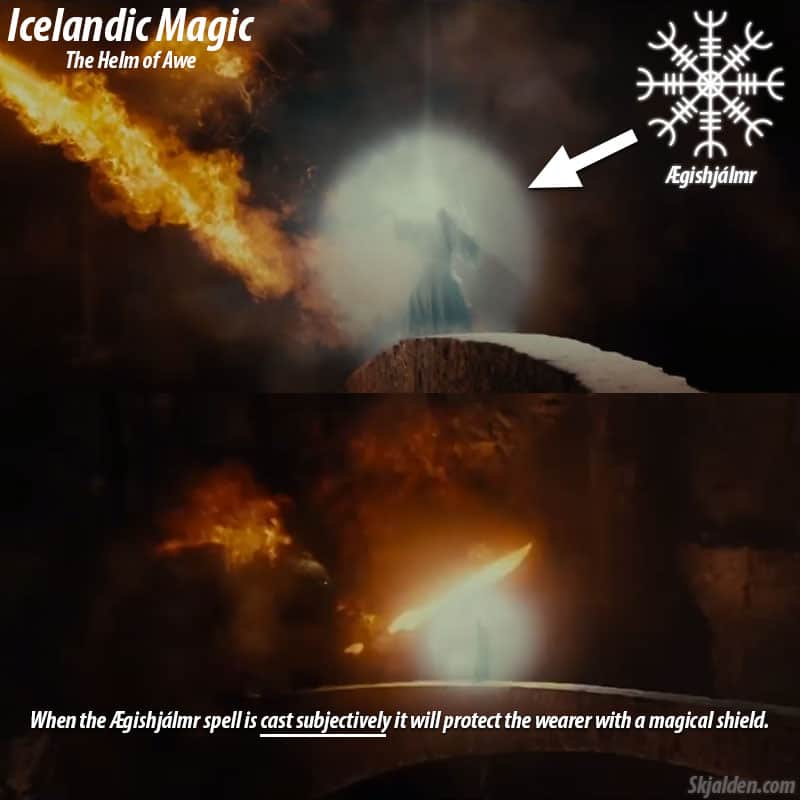
If the spell is cast objectively it functions as a transformation spell, just like when the dwarf Fafnir transformed himself into the form of a serpent/dragon to protect his treasure.
Is it really just a coincidence that the word Ægishjalmr is mentioned in Fáfnismál, and that there is a depiction of a symbol with a similar description that actually could fit the description in the saga? Of course, we have to remember that there still were around 300 years between the publication of the two books, but it does make you wonder, right?
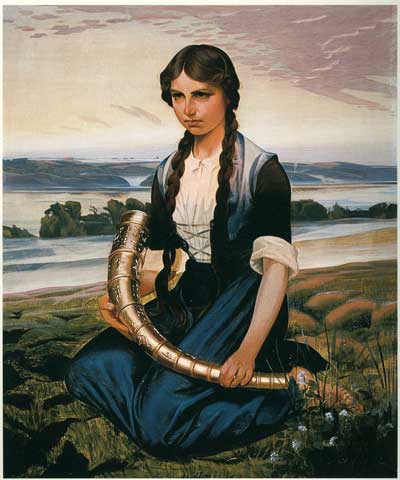
There is one source that I would like to put on the table, and a source that I have not seen anyone else use in the connection with the Helm of Awe, and that is the golden horns of Gallehus that was discovered in Denmark. These two golden horns have been dated to the early 5th century (400 CE), which is within the Germanic Iron Age, and prior to the Viking Age.

What is interesting about these golden horns in this context is the symbols. I won’t go through everything, since I have already made an article about the golden horns of Gallehus, so we are only going to focus on one particular symbol, which is located at the top of one of the horns.
When I saw this symbol the first time, I was like, by Odin’s beard I have seen that one before. It may not look exactly identical to the one depicted in the book of magic (Galdrabók), but the symbol could have evolved through the millennium.
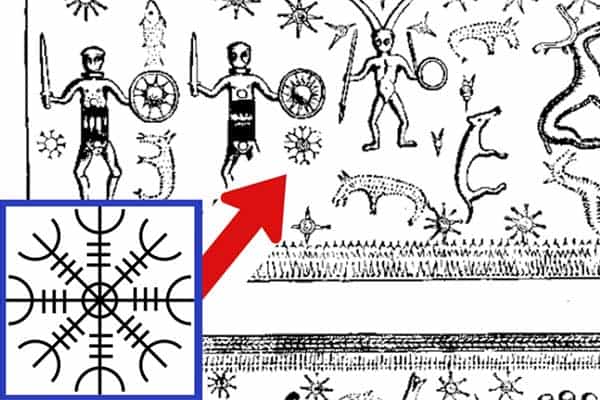

A popular source that is often used in connection with Germanic paganism, and to explain the origin of these rune spells are the keys of Solomon. There might be some truth to that, but if one of these keys can be interpreted as the Helm of Awe, while only having a similar appearance, then the same could also be said for the depiction on the golden horn.
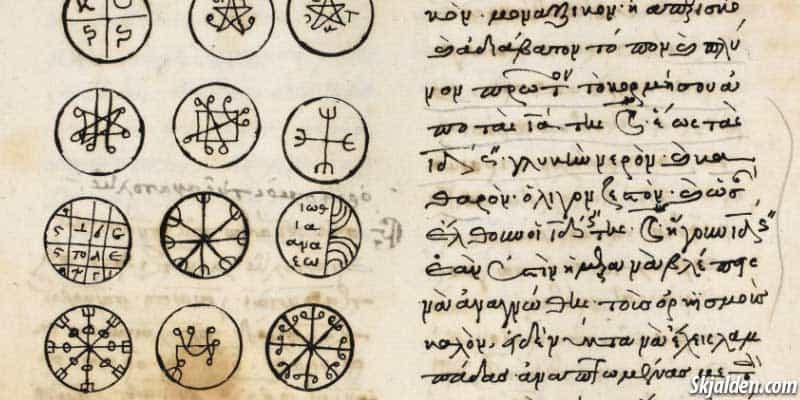
I would like to point out, that when we tend to think about the symbol we always visualize it with eight arms stretching outwards from the center. This way of depicting the symbol has become quite common and can be found in most if not all stores that sell Viking-inspired jewelry.
But according to Stephen Flowers, there are various versions of this symbol. It can consist of four, six, or eight arms with other symbols along the arms. The number of arms and the shape of the Helm of Awe depends on which magical space the magician wants to be modeled.
“The eight-armed Helm of Awe is a reference to the four cardinal directions and four vertical worlds along an axis both above and below the subject as conceived of anywhere in space. The two inner worlds on the vertical axis are both above and below the subject, but the outer two on the vertical pole are actually in another dimension of time and space: these correspond to the realm from which events originate and the realm where transformations are made.”
“Obviously the number of arms on a helm gives an indication of the way in which magical space is being modeled: typically the helms have eight, six, or four arms. Eight arms refer to the eight divisions of the sky and earth (the ættir); six arms refer to the four cardinal points and a vertical axis; while four arms refer to the cardinal points of the mundane universe. However, many more configurations are possible.” – Stephen E. Flowers. (Icelandic Magic: Practical Secrets of the Northern Grimoires, p 76)
If we take a look at the golden horns again, then we can see that there is only one symbol that looks like the Helm of Awe, but it clearly looks different than the rest, it stands out. Its placement is also very interesting, right next to two warriors with their weapons drawn.
According to the researcher Finn Rasmussen, this is a depiction of the Germanic heaven. The two figures with horns are divine twins. The one to the left is the God of life and growth which is symbolized with the ring that symbolizes the circle of life, and a wand that symbolizes an object that can revive beings. The twin also has a spear in its hand which symbolizes strength and courage.
The divine twin to the right is the God of death and harvest, which is symbolized by the sickle. This makes me wonder if the Grim Reaper which has been depicted many times in Christianity has its roots in Germanic paganism. The twin also has a stick in the left hand to guide people through the realm of the dead.

I have been thinking about this section of the horn for quite some time, and is it possible that this is a depiction of a ritual conducted by religious leaders? Who cast the rune spell on their warriors before a battle? We have found helmets that look similar, these have been dated to the bronze age 1700 BCE – 500 BCE, and they were found at Veksø in Zealand, Denmark.
Another thought that I have had, and I just want to clarify that I don’t smoke any kind of herbs, but could they be a depiction of interdimensional beings that are somehow related to the use of magic? As I said earlier, the spell can also be extended objectively to protect the surroundings of the magician, for instance, groups of people.
“What makes this symbol an especially powerful “map of magic” is that it connects the subjective and objective universes in a synthetic way, which gives the inner will of the magician a high level of influence over the objective universe because both realms are clearly seen as part of the same whole.” – Stephen E. Flowers. (Icelandic Magic: Practical Secrets of the Northern Grimoires, p 74)
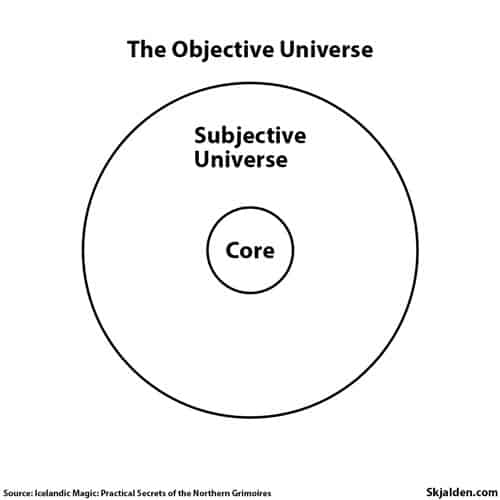
This can be illustrated in a two-dimensional drawing, the objective universe is the surroundings of the magician. The subjective universe is the soul and mind of the magician, and at the core is the goal or the intent of the magic. According to Steven Flowers, these zones can be adjusted based on the empirical results of magical experiments.
“In casting a Helm of Awe the magician is to imagine the arms of the sign as currents of force emitting from the core of his being and flowing both outwardly and inwardly – being protected forcefully remaining steady, being received forcefully or being blocked, redirected or circulated as the sign determines. Again, the key is that the sign is not two-dimensional, but it exists on at least four dimensions.” – Stephen E. Flowers. (Icelandic Magic: Practical Secrets of the Northern Grimoires, p 75)
This clearly indicates that magic can not just be conducted by anyone, the person has to have an almost spiritual connection and be confident in it. This emotional aspect may explain why it was mostly women who not only were the religious leader of society but also more often someone who practiced magic.
For a spell to be cast successfully, it is probably necessary that the emotions have to be controlled, focused, and guided by the force, and someone can not just pick up a book and begin to cast rune spells, the person has to have an inner calmness and be in control of the self, which only comes with meditation.
In contrast to what some people may think, meditation is not just used in religions such as Hinduism or Buddhism, but it was also practiced within Germanic paganism. So when some western people feel that they have more in common with Buddhism, they are actually just reaching back to their own Pagan roots.
Helm of Awe is combined by runes
If we take a closer look at the symbol, then the Helm of Awe has allegedly been made by using Z-runes as its arms – (Galdrabók, p 122). This rune is called Algiz and it is part of the runic alphabet Elder Futhark, its transliteration is the letter “z”. This rune is also part of the runic alphabet Younger Futhark where it is called Yr, however, here the transliteration is the letter “R”. This rune is associated with protection and prevailing over one’s enemies, which is most likely why it was used for this symbol.
Along the arm is the Isa rune which also appears in both of the runic alphabets. The transliteration of this rune is the letter “i”, and the meaning of the Isa rune is ice. If you think that it is only the Icelandic language that is filled with words from Old Norse, then you should rethink that opinion. Because, for instance, in Danish is the word for ice “is”.
Of course, it is difficult to know if this is, in fact, the Isa rune along its arms, but if it is, then it’s quite interesting. The use of this rune could be understood as the Helm of Awe was hardened with the strength of ice. Ice can be an incredibly hard and resistant element that can be almost impossible to break without the right tools. Therefore, it would make sense that the ancients thought of ice as being unbreakable, and therefore, used it as part of a magical shield.
Could this mean that the Helm of Awe is a magical shield that consists of ice, and a spell that is cast subjectively to protect the wearer and their surroundings, and was this, in fact, a rune spell, that was used in connection with resisting violent encounters? While still being able to fight back, and defeat the enemy?
Does it have a sun cross?
I would like to insert one of my own speculations, in my opinion, the middle of the symbol looks a lot like the sun cross. Which is a very ancient symbol that can be seen across many cultures, but is it possible that the sun cross could have had more lines, for instance, in order to split the year into dates that could somehow have been important?
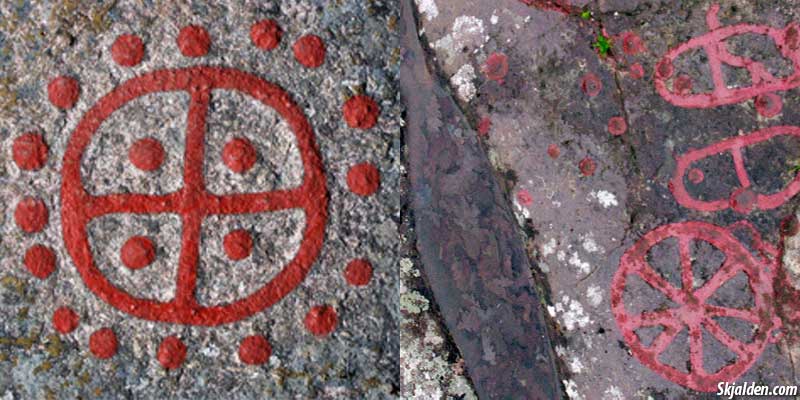
Is it possible that the Helm of Awe has the sun cross in the center? I have not seen anyone else write about it, but it was just a thought that crossed my mind.
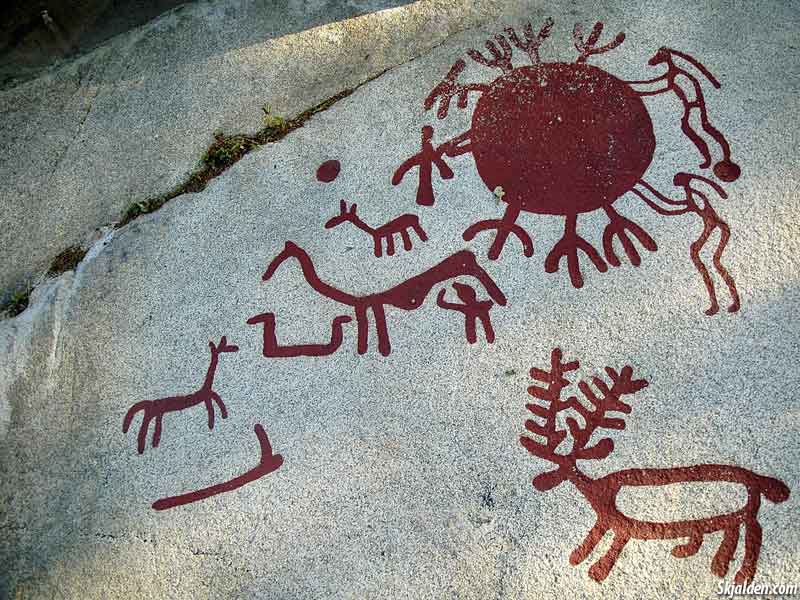
These images on the stones have been found in many parts of Scandinavia, and they date back to the Bronze Age. Everyone is in agreement that this is a sun cross/sun wheel, so if this represented the sun, then what the heck is this? I mean, it does look like an early depiction of the Helm of Awe, or is my imagination running wild?
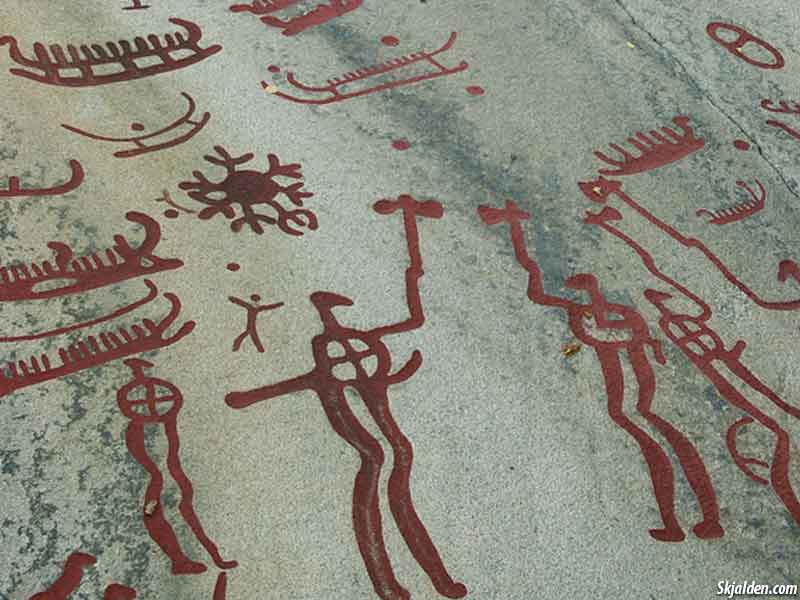
All of these images are from the rock carvings In Tanum, Sweden, and they have been dated to the Bronze Age (1800 BCE – 500 BCE). This image allegedly depicts two women and a sun cross/sun wheel. It is also depicted above two warriors in what looks to be a battle scene. Of course, this could just be the sun, I am not concluding anything, I just thought it was interesting.
The exact age of the Helm of Awe is unknown, but claiming that it has no ties to the Viking Age, while there are similar symbols, and that the name is the same as the depiction from the book published in the 1600s is, in my opinion, a bit ridicules.
There clearly is some form of connection across hundreds of years, and possibly even all the way back to prehistoric times when people carved their daily life onto rocks. I think that there is still a lot of research that can be conducted in connection with this symbol, and I think there is still a lot to be discovered.
Academical and mythological research is important, but we can not neglect to look at the philosophical and spiritual aspects. If we take everything literally and don’t try to think outside the box, then we may never understand how the ancient people thought.
This is not an exact answer to the origin of the Helm of Awe, but it was never my intention to make that path through time. The intention was an exploration, and to make you more enlightened about the fact that everything may not always be as it seems, and that there is clearly more to this symbol than we know.
Sources:
The Galdrabók, March 3, 2011, by Stephen E Flowers.
Icelandic Magic: Practical Secrets of the Northern Grimoires, 2016, by Stephen E Flowers.
Huld Manuscript of Galdrastafir Witchcraft Magic Symbols and Runes – English Translation

